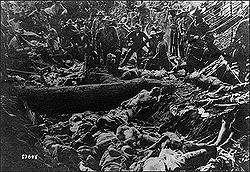First Battle of Bud Dajo
| Moro Crater Massacre | |||||||
|---|---|---|---|---|---|---|---|
| Part of the Moro Rebellion | |||||||
 U.S. soldiers pose with Moro dead after the battle |
|||||||
|
|||||||
| Belligerents | |||||||
|
|
|
||||||
| Commanders and leaders | |||||||
| General Leonard Wood Col. Joseph W. Duncan |
|||||||
| Strength | |||||||
| 750 | 1,000+ Moro people | ||||||
| Casualties and losses | |||||||
| 21 killed, 70 wounded |
994 killed, including women and children | ||||||
The First Battle of Bud Dajo, also known as the Bud Dajo Massacre, in southwestern Philippines was a counter insurgency action fought by the United States Army against Moros in March 1906, during the Moro Rebellion. While fighting was limited to ground action on Jolo Island in the Sulu Archipelago, use of naval gunfire contributed significantly to the overwhelming firepower brought to bear against the Moros. Whether the occupants of Bud Dajo were hostile to U.S. forces is disputed, as inhabitants of Jolo had previously used the crater as a place of refuge during Spanish assaults on the island and Major Hugh Scott, the Sulu District Governor, recounted that those who fled to the crater "declared they had no intention of fighting, - ran up there only in fright, [and] had some crops planted and desired to cultivate them." Moro men in the crater who had arms possessed melee weapons. The description of the engagement as a battle is disputed because of both the overwhelming firepower of the attackers and the lopsided casualties. The conflict, especially the final phase of the battle, is also known as the Moro Crater Massacre.
During this battle, 750 men and officers, under the command of Colonel J.W. Duncan, assaulted the volcanic crater of Bud Dajo (Tausūg: Būd Dahu), which was populated by 800 to 1,000 Tausug villagers, including women and children. According to Herman Hagedorn (who was writing prior to World War II), the position held by the Moros was "the strongest which hostiles in the Philippines have ever defended against American assault." Although the engagement was a victory for the American forces, it was also an unmitigated public-relations disaster. Considering the perspective that the engagement was a massacre, however, then the engagement had no victor. Whether a battle or massacre, it was certainly the bloodiest of any engagement of the Moro Rebellion, with only six of the hundreds of Moro surviving the bloodshed. Estimates of American casualties range from fifteen killed to twenty-one killed and seventy-five wounded.
...
Wikipedia
